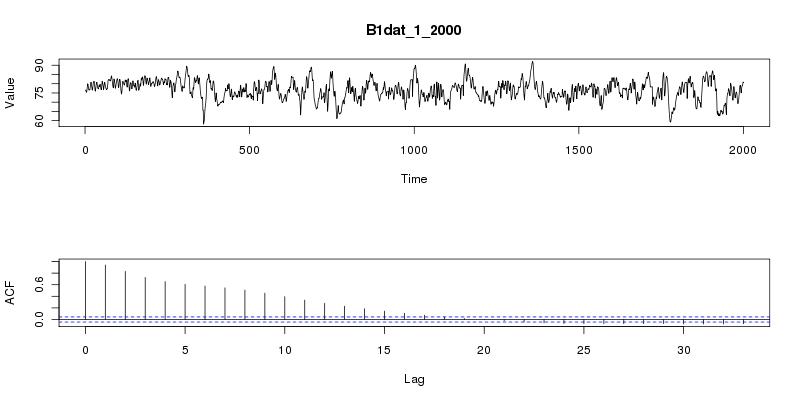

| |
| |
| KEEL-dataset - data set description |
This section describes main characteristics of the B1dat_1_2000 data set and its attributes:
General information
| Physiological (part 1) data set | |||
|---|---|---|---|
| Type | Time series | Origin | Real world |
| Features | 4 | (Real / Integer / Nominal) | (4 / 0 / 0) |
| Instances | 1995 | Missing values? | No |
Attribute description
| Attribute | Domain |
|---|---|
| Lag04 | [58.15,92.01] |
| Lag03 | [58.15,92.01] |
| Lag02 | [58.15,92.01] |
| Lag01 | [58.15,92.01] |
| Lag00 | [58.15,92.01] |
Additional information
This is the first part of a multivariate data set recorded from a patient in the sleep laboratory of the Beth Israel Hospital in Boston, Massachusetts (data submitted by David Rigney and Ary Goldberger). The lines in the original data set file are spaced by 0.5 seconds. The first column is the heart rate, the second is the chest volume (respiration force), and the third is the blood oxygen concentration (measured by ear oximetry). The heart rate was determined by measuring the time between the QRS complexes in the electrocardiogram, taking the inverse, and then converting this to an evenly sampled record by interpolation. There were no premature beats - sudden changes in the heart rate are not artifacts. The respiration and blood oxygen data are given in uncalibrated A/D bits; these two sensors slowly drift with time (and are therefore occasionally rescaled by a technician) and can be detached by the motion of the patient, hence their calibration is not constant over the data set. They were converted from 250 Hz to 2 Hz data by averaging over a 0.08 second window at the times of the heart rate samples. Between roughly 4 hours 30 minutes and 4 hours 34 minutes from the start of the file the sensors were disconnected.
In this section you can download some files related to the B1dat_1_2000 data set:
- The complete data set already formatted in KEEL format can be downloaded from
here
 .
. - A copy of the data set already partitioned by means of a 5-folds cross validation procedure can be downloaded from here
 .
. - The header file associated to this data set can be downloaded from here
 .
. - This is not a native data set from the KEEL project. It has been obtained from the The Santa Fe Time Series Competition Data. The original page where the data set can be found is: http://www-psych.stanford.edu/~andreas/Time-Series/SantaFe.html.
|
Copyright 2004-2018,
KEEL (Knowledge Extraction based on Evolutionary Learning)
About the Webmaster Team |










